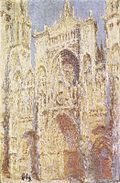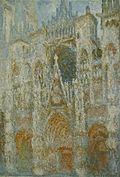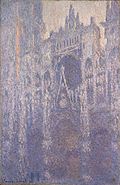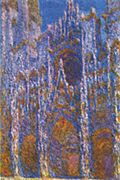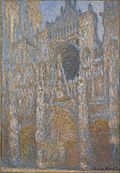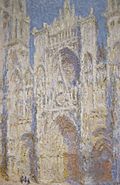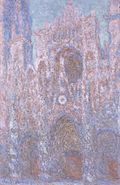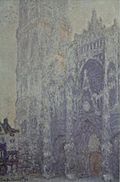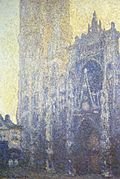Rouen Cathedral (Monet) facts for kids
Quick facts for kids Rouen Cathedral, Full Sunlight |
|
|---|---|
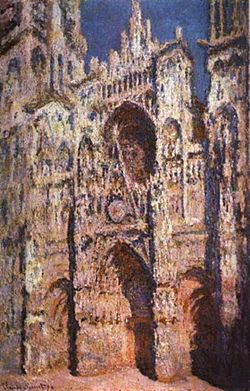 |
|
| Artist | Claude Monet |
| Year | 1894 |
| Medium | Oil on canvas |
| Dimensions | 107 cm × 73.5 cm (42 in × 28.9 in) |
| Location | Musée d'Orsay, Paris |
The Rouen Cathedral series is a famous group of paintings by the French artist Claude Monet. He was an impressionist painter, known for capturing how light changes things. In the 1890s, Monet painted the front of Rouen Cathedral many times. Each painting shows the cathedral at different times of day or year. This highlights how light makes the building look different.
Contents
Painting the Cathedral: A Series
Monet created more than thirty paintings of the Rouen Cathedral. He painted them in 1892 and 1893 in Rouen, Normandy. He rented rooms across from the cathedral to use as his temporary art studio. Later, in 1894, he worked on the paintings more in his own studio.
In 1895, Monet chose twenty of his best cathedral paintings. He showed them at a gallery in Paris. Eight of these paintings were sold even before the show ended! Other famous artists, like Camille Pissarro and Paul Cézanne, saw the exhibition. They thought the series was amazing.
At that time, many people in France were becoming more interested in their history and religion. The Rouen Cathedral was a perfect subject. It was built in the beautiful Gothic style. This style was admired across Europe. The cathedral showed the best of French history and culture.
Capturing Light and Time
Monet had always been fascinated by light. He saw how light changes how things look. It changes with the time of day, the season, and even the weather. For Monet, the way light hit something became as important as the thing itself.
He painted many series of artworks. For example, his famous Water Lilies series also shows the same subject many times. Each painting in these series tries to show how light affects what we see. It helps us understand how light changes our view of a place at a certain moment.
-
Rouen Cathedral, West Façade, Sunlight
1894
National Gallery of Art
Washington, D.C., USA -
Rouen Cathedral, red, Sunlight
1892
National Museum of Serbia
Belgrade, Serbia -
La Cathédrale de Rouen. Le portail et la tour Saint-Romain, plein soleil; harmonie bleue et or
1892–1893
Musée d'Orsay
Paris, France -
La Cathédrale de Rouen. Le portail, soleil matinal; harmonie bleue
1892–1893
Musée d'Orsay
Paris, France -
Rouen Cathedral, Facade (sunset), harmonie in gold and blue
1892–1894
Musée Marmottan Monet
Paris, France
A writer named Robert Pelfrey explained Monet's goal. He said that by painting the same thing over and over, Monet could focus on how light made it look. The cathedral itself didn't change. But the way it looked, because of the changing light, was always different.
The cathedral series was not Monet's first series. But it was his most detailed. Before this, Monet mostly painted landscapes. The cathedral was a new kind of subject for him. It helped him show a cool idea: a strong, solid building that looks different all the time because of changing light. Some people wanted the government to buy all the paintings. They wanted to show them together. But this didn't happen, and the paintings were sold separately.
Monet's Painting Technique
Painting the cathedral was very hard for Monet. Michael Howard, who wrote about Impressionism, said Monet had a lot of trouble. He even had nightmares about the cathedral falling on him in different colors. Monet wrote that he was "trying to do the impossible." He found that capturing light, which changes so fast, was extremely difficult.
Monet was good at quickly sketching a scene. Then he would finish the painting later, using his sketch and his memory. For these cathedral paintings, he used thick layers of paint. This made the paintings feel textured, like the stone of the cathedral itself.
Paul Hayes Tucker, who wrote about Monet, described this. He said Monet's amazing skill was not just seeing nature's effects. It was also how he used his paint. The surfaces of these paintings are covered with thick paint. Monet built it up layer by layer, just like the stone blocks of the cathedral's front.
Monet used many colors woven together. He had a sharp eye for detail. He also used a lot of texture in his paint. All these things helped him create paintings that seem to shimmer with light and color. They are true masterpieces, just like the grand cathedral they show.
Gallery
-
The portal and the tower of the saint-romain at morning sun, Harmony in Blue
1893
Musée d'Orsay
Paris, France -
Rouen Cathedral, Facade (Morning effect)
1892–1894
Folkwang Museum
Essen, Germany -
Rouen Cathedral, Facade 1
1892–1894
Pola Museum of Art
Hakone, Japan -
Rouen Cathedral, The Façade in Sunlight
1894
Clark Art Institute
Williamstown, USA -
Rouen Cathedral, West Facade, 1894, National Gallery of Art
-
Rouen Cathedral, West Facade, Sunlight, 1894, National Gallery of Art
-
Rouen Cathedral- Setting Sun, (Symphony in Grey and Pink), 1894, National Museum Cardiff, Great Britain
-
La Cathédrale de Rouen. Le portail et la tour Saint-Romain, effet du matin; harmonie blanche
1892–1893
Musée d'Orsay
Paris, France -
Rouen Cathedral, Facade and Tour d'AlbaneI, dull day
1892–1894
Beyeler Museum
Riehen, Switzerland -
Rouen Cathedral, the West Portal, Dull Weather
1892
Musée d'Orsay
Paris, France
Where to See the Paintings
Many museums around the world own paintings from the Rouen Cathedral series.
In 1994, the Musée des Beaux-Arts de Rouen showed sixteen paintings from the series.
The Musée d'Orsay in Paris always has five of these paintings on display.
In 2018, the National Gallery in London had a special show. They displayed five paintings from the series together in one room. This exhibition was called Monet & Architecture. It showed how Monet used buildings to make his art more interesting. This was a rare event. Most museums don't own more than three of these paintings. Also, the paintings from the Musée d'Orsay were not part of this London show.
The five paintings shown in London came from these places:
- National Museum Cardiff
- Klassik Stiftung Weimar
- Museum of Fine Arts
- Beyeler Foundation
- An art collection that wishes to remain private
See also
- List of paintings by Claude Monet


